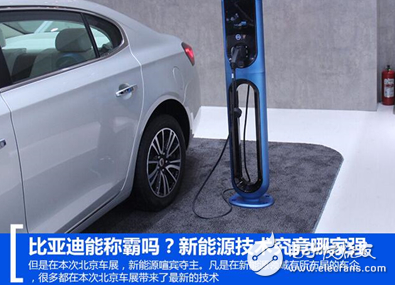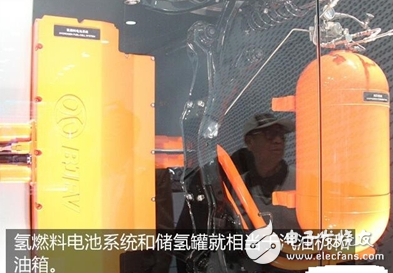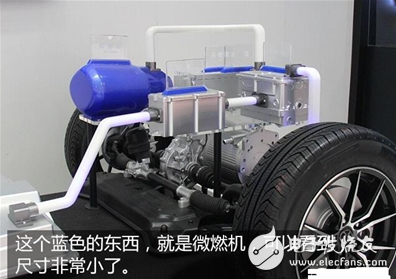The 2016 Beijing International Auto Show has officially kicked off today. At this auto show, domestic and foreign auto companies have come up with their own housekeeping skills. According to public information, there are 112 first-time vehicles in the world, 33 global first-time vehicles for multinational corporations, 21 Asian first-time vehicles for multinational companies, 46 concept vehicles, and 147 new energy vehicles.

In the past auto show, the new car of the international big factory has always been the focus of attention. However, at this Beijing Auto Show, the new energy company took the lead. Many car companies that have been deployed in the new energy field have brought the latest technology to this Beijing Auto Show. Then please follow my steps and take a look at it. Which new energy technology is strong?
BAIC: Two Extended Program Technologies
The current products of BAIC New Energy are all pure electric vehicles, but at this auto show, we learned that there are other layouts for BAIC. There are 2 incremental programs.
What is an extension program? The traditional extension program has motors, batteries, gasoline engines, and gasoline. However, the gasoline engine does not drive the vehicle forward, but is responsible for generating electricity and using the motor as a driving source. However, the two technologies of BAIC did not use gasoline engines to generate electricity.

This structure is like this, the front is the motor, the bottom of the chassis is the battery, this is no different from the traditional electric car. There is a hydrogen fuel cell system and a hydrogen storage tank.

By asking the field staff, the hydrogen storage tank is 74 liters, which can provide an additional 300 kilometers of battery life, while the battery can provide 200 kilometers of battery life, with a total of 500 kilometers of battery life. This is bigger than the average family car mailbox, and because the fuel tank of the gasoline is flat on the bottom of the car, it will not encroach on the trunk, and the hydrogen storage tank will certainly encroach on the trunk.

In addition to this hydrogen fuel extended range electric vehicle, there is another incremental program technology. According to the official statement of BAIC, it is a micro-combustion engine extended range electric vehicle. The micro-combustion engine can be considered as a type of gas turbine, but it is more compact and can be used in a home automobile. Gas turbines have also seen some concept cars and some racing cars that have been linearly accelerated, but they have not been popularized in family cars.

The working principle of the micro-combustion engine is different from that of the conventional four-stroke internal combustion engine. In short, the air is sucked in and compressed, and then burned in the combustion chamber, and the high-temperature and high-pressure gas generated pushes the turbine to rotate, completing the chemical energy to the kinetic energy. Conversion. Gas turbines are more thermally efficient than conventional four-stroke internal combustion engines.

However, the current cost of gas turbines is very high and the technology is very complicated. BAIC admits that it has not yet developed the capability of micro-combustion engines. And why it is used for extended range, mainly because gas turbines are more suitable for stable load conditions, so use it to generate electricity instead of direct drive.
Comments: These two technologies belong to the typical concept to the very popular technology, and the difficulties to be overcome are numerous. It is not difficult to use these two technologies as exhibitions. How to apply them to family cars is the fundamental. Hydrogen fuel, to solve the problem of hydrogenation. The micro-combustion engine must be able to be built first, and the cost problem must be solved. Therefore, there are many difficulties, so the concept is still quite large. The concept is exaggerated, and the concept may be more appropriate. But objectively, BAIC has demonstrated this technology and provided more directions for developing new energy. After all, it is not a bad thing.
Introduction
SCOTECH manufactures a full range of cast resin dry type transformers ,they are designed primary as an MV insulation system, cast resin technology provides excellent insulation and environmental protection, this together with the foil winding technology inside the resin offers the ultimate Dry Type Transformer in terms of dielectric performance and short circuit withstand and ensures long term reliability for both distribution and special applications. Cast resin transformers can be supplied with either aluminum or copper windings together with possibility of class F or class H resin system.
Advantages
Fire resistant /Self-extinguishing(F1)
Environmental class(E2) and climatic class (C2)
From IP00-IP56 enclosure with AN, AF, ANAF or AFWF cooling
Free maintenance
Environmental friendly ,>90% of material recyclable
Scope of supply
Voltage level: up to 35KV
Rating level: up to 20MVA
Standards
SCOTECH`s cast resin dry type transformers are designed and manufactured in accordance with all major international standards (IEC, ANSI, UL, CSA etc.)
Why SCOTECH
Long history- Focus on transformer manufacturing since 1934.
Technical support – 134 engineers stand by for you 24/7.
Manufacturing-advanced production and testing equipment, strict QA system.
Perfect service-The complete customer service package (from quotation to energization).
Cast Resin Dry Type Transformer
Dry Transformer,Cast Resin Transformer,Resin Encapsulated Transformer,Cast Resin Dry Type Transformer
Jiangshan Scotech Electrical Co.,Ltd , https://www.scotech.com